IEEE Standard for Verilog® Hardware Description Language
Introduction
Notice to users
Errata
Interpretations
Patents
Participants
Contents
List of Figures
List of Tables
List of Syntax Boxes
IEEE Standard for Verilog® Hardware Description Language
1. Overview
1.1 Scope
1.2 Conventions used in this standard
1.3 Syntactic description
1.4 Use of color in this standard
1.5 Contents of this standard
1.6 Deprecated clauses
1.7 Header file listings
1.8 Examples
1.9 Prerequisites
2. Normative references
3. Lexical conventions
3.1 Lexical tokens
3.2 White space
3.3 Comments
3.4 Operators
3.5 Numbers
3.5.1 Integer constants
3.5.2 Real constants
3.5.3 Conversion
3.6 Strings
3.6.1 String variable declaration
3.6.2 String manipulation
3.6.3 Special characters in strings
3.7 Identifiers, keywords, and system names
3.7.1 Escaped identifiers
3.7.2 Keywords
3.7.3 System tasks and functions
3.7.4 Compiler directives
3.8 Attributes
3.8.1 Examples
3.8.2 Syntax
4. Data types
4.1 Value set
4.2 Nets and variables
4.2.1 Net declarations
4.2.2 Variable declarations
4.3 Vectors
4.3.1 Specifying vectors
4.3.2 Vector net accessibility
4.4 Strengths
4.4.1 Charge strength
4.4.2 Drive strength
4.5 Implicit declarations
4.6 Net types
4.6.1 Wire and tri nets
4.6.2 Wired nets
4.6.3 Trireg net
4.6.4 Tri0 and tri1 nets
4.6.5 Unresolved nets
4.6.6 Supply nets
4.7 Regs
4.8 Integers, reals, times, and realtimes
4.8.1 Operators and real numbers
4.8.2 Conversion
4.9 Arrays
4.9.1 Net arrays
4.9.2 reg and variable arrays
4.9.3 Memories
4.10 Parameters
4.10.1 Module parameters
4.10.2 Local parameters (localparam)
4.10.3 Specify parameters
4.11 Name spaces
5. Expressions
5.1 Operators
5.1.1 Operators with real operands
5.1.2 Operator precedence
5.1.3 Using integer numbers in expressions
5.1.4 Expression evaluation order
5.1.5 Arithmetic operators
5.1.6 Arithmetic expressions with regs and integers
5.1.7 Relational operators
5.1.8 Equality operators
5.1.9 Logical operators
5.1.10 Bitwise operators
5.1.11 Reduction operators
5.1.12 Shift operators
5.1.13 Conditional operator
5.1.14 Concatenations
5.2 Operands
5.2.1 Vector bit-select and part-select addressing
5.2.2 Array and memory addressing
5.2.3 Strings
5.3 Minimum, typical, and maximum delay expressions
5.4 Expression bit lengths
5.4.1 Rules for expression bit lengths
5.4.2 Example of expression bit-length problem
5.4.3 Example of self-determined expressions
5.5 Signed expressions
5.5.1 Rules for expression types
5.5.2 Steps for evaluating an expression
5.5.3 Steps for evaluating an assignment
5.5.4 Handling X and Z in signed expressions
5.6 Assignments and truncation
6. Assignments
6.1 Continuous assignments
6.1.1 The net declaration assignment
6.1.2 The continuous assignment statement
6.1.3 Delays
6.1.4 Strength
6.2 Procedural assignments
6.2.1 Variable declaration assignment
6.2.2 Variable declaration syntax
7. Gate- and switch-level modeling
7.1 Gate and switch declaration syntax
7.1.1 The gate type specification
7.1.2 The drive strength specification
7.1.3 The delay specification
7.1.4 The primitive instance identifier
7.1.5 The range specification
7.1.6 Primitive instance connection list
7.2 and, nand, nor, or, xor, and xnor gates
7.3 buf and not gates
7.4 bufif1, bufif0, notif1, and notif0 gates
7.5 MOS switches
7.6 Bidirectional pass switches
7.7 CMOS switches
7.8 pullup and pulldown sources
7.9 Logic strength modeling
7.10 Strengths and values of combined signals
7.10.1 Combined signals of unambiguous strength
7.10.2 Ambiguous strengths: sources and combinations
7.10.3 Ambiguous strength signals and unambiguous signals
7.10.4 Wired logic net types
7.11 Strength reduction by nonresistive devices
7.12 Strength reduction by resistive devices
7.13 Strengths of net types
7.13.1 tri0 and tri1 net strengths
7.13.2 trireg strength
7.13.3 supply0 and supply1 net strengths
7.14 Gate and net delays
7.14.1 min:typ:max delays
7.14.2 trireg net charge decay
8. User-defined primitives (UDPs)
8.1 UDP definition
8.1.1 UDP header
8.1.2 UDP port declarations
8.1.3 Sequential UDP initial statement
8.1.4 UDP state table
8.1.5 Z values in UDP
8.1.6 Summary of symbols
8.2 Combinational UDPs
8.3 Level-sensitive sequential UDPs
8.4 Edge-sensitive sequential UDPs
8.5 Sequential UDP initialization
8.6 UDP instances
8.7 Mixing level-sensitive and edge-sensitive descriptions
8.8 Level-sensitive dominance
9. Behavioral modeling
9.1 Behavioral model overview
9.2 Procedural assignments
9.2.1 Blocking procedural assignments
9.2.2 The nonblocking procedural assignment
9.3 Procedural continuous assignments
9.3.1 The assign and deassign procedural statements
9.3.2 The force and release procedural statements
9.4 Conditional statement
9.4.1 If-else-if construct
9.5 Case statement
9.5.1 Case statement with do-not-cares
9.5.2 Constant expression in case statement
9.6 Looping statements
9.7 Procedural timing controls
9.7.1 Delay control
9.7.2 Event control
9.7.3 Named events
9.7.4 Event or operator
9.7.5 Implicit event_expression list
9.7.6 Level-sensitive event control
9.7.7 Intra-assignment timing controls
9.8 Block statements
9.8.1 Sequential blocks
9.8.2 Parallel blocks
9.8.3 Block names
9.8.4 Start and finish times
9.9 Structured procedures
9.9.1 Initial construct
9.9.2 Always construct
10. Tasks and functions
10.1 Distinctions between tasks and functions
10.2 Tasks and task enabling
10.2.1 Task declarations
10.2.2 Task enabling and argument passing
10.2.3 Task memory usage and concurrent activation
10.3 Disabling of named blocks and tasks
10.4 Functions and function calling
10.4.1 Function declarations
10.4.2 Returning a value from a function
10.4.3 Calling a function
10.4.4 Function rules
10.4.5 Use of constant functions
11. Scheduling semantics
11.1 Execution of a model
11.2 Event simulation
11.3 The stratified event queue
11.4 Verilog simulation reference model
11.4.1 Determinism
11.4.2 Nondeterminism
11.5 Race conditions
11.6 Scheduling implication of assignments
11.6.1 Continuous assignment
11.6.2 Procedural continuous assignment
11.6.3 Blocking assignment
11.6.4 Nonblocking assignment
11.6.5 Switch (transistor) processing
11.6.6 Port connections
11.6.7 Functions and tasks
12. Hierarchical structures
12.1 Modules
12.1.1 Top-level modules
12.1.2 Module instantiation
12.2 Overriding module parameter values
12.2.1 defparam statement
12.2.2 Module instance parameter value assignment
12.2.3 Parameter dependence
12.3 Ports
12.3.1 Port definition
12.3.2 List of ports
12.3.3 Port declarations
12.3.4 List of ports declarations
12.3.5 Connecting module instance ports by ordered list
12.3.6 Connecting module instance ports by name
12.3.7 Real numbers in port connections
12.3.8 Connecting dissimilar ports
12.3.9 Port connection rules
12.3.10 Net types resulting from dissimilar port connections
12.3.11 Connecting signed values via ports
12.4 Generate constructs
12.4.1 Loop generate constructs
12.4.2 Conditional generate constructs
12.4.3 External names for unnamed generate blocks
12.5 Hierarchical names
12.6 Upwards name referencing
12.7 Scope rules
12.8 Elaboration
12.8.1 Order of elaboration
12.8.2 Early resolution of hierarchical names
13. Configuring the contents of a design
13.1 Introduction
13.1.1 Library notation
13.1.2 Basic configuration elements
13.2 Libraries
13.2.1 Specifying libraries-the library map file
13.2.2 Using multiple library map files
13.2.3 Mapping source files to libraries
13.3 Configurations
13.3.1 Basic configuration syntax
13.3.2 Hierarchical configurations
13.4 Using libraries and configs
13.4.1 Precompiling in a single-pass use model
13.4.2 Elaboration-time compiling in a single-pass use model
13.4.3 Precompiling using a separate compilation tool
13.4.4 Command line considerations
13.5 Configuration examples
13.5.1 Default configuration from library map file
13.5.2 Using default clause
13.5.3 Using cell clause
13.5.4 Using instance clause
13.5.5 Using hierarchical config
13.6 Displaying library binding information
13.7 Library mapping examples
13.7.1 Using the command line to control library searching
13.7.2 File path specification examples
13.7.3 Resolving multiple path specifications
14. Specify blocks
14.1 Specify block declaration
14.2 Module path declarations
14.2.1 Module path restrictions
14.2.2 Simple module paths
14.2.3 Edge-sensitive paths
14.2.4 State-dependent paths
14.2.5 Full connection and parallel connection paths
14.2.6 Declaring multiple module paths in a single statement
14.2.7 Module path polarity
14.3 Assigning delays to module paths
14.3.1 Specifying transition delays on module paths
14.3.2 Specifying x transition delays
14.3.3 Delay selection
14.4 Mixing module path delays and distributed delays
14.5 Driving wired logic
14.6 Detailed control of pulse filtering behavior
14.6.1 Specify block control of pulse limit values
14.6.2 Global control of pulse limit values
14.6.3 SDF annotation of pulse limit values
14.6.4 Detailed pulse control capabilities
15. Timing checks
15.1 Overview
15.2 Timing checks using a stability window
15.2.1 $setup
15.2.2 $hold
15.2.3 $setuphold
15.2.4 $removal
15.2.5 $recovery
15.2.6 $recrem
15.3 Timing checks for clock and control signals
15.3.1 $skew
15.3.2 $timeskew
15.3.3 $fullskew
15.3.4 $width
15.3.5 $period
15.3.6 $nochange
15.4 Edge-control specifiers
15.5 Notifiers: user-defined responses to timing violations
15.5.1 Requirements for accurate simulation
15.5.2 Conditions in negative timing checks
15.5.3 Notifiers in negative timing checks
15.5.4 Option behavior
15.6 Enabling timing checks with conditioned events
15.7 Vector signals in timing checks
15.8 Negative timing checks
16. Backannotation using the standard delay format (SDF)
16.1 The SDF annotator
16.2 Mapping of SDF constructs to Verilog
16.2.1 Mapping of SDF delay constructs to Verilog declarations
16.2.2 Mapping of SDF timing check constructs to Verilog
16.2.3 SDF annotation of specparams
16.2.4 SDF annotation of interconnect delays
16.3 Multiple annotations
16.4 Multiple SDF files
16.5 Pulse limit annotation
16.6 SDF to Verilog delay value mapping
17. System tasks and functions
17.1 Display system tasks
17.1.1 The display and write tasks
17.1.2 Strobed monitoring
17.1.3 Continuous monitoring
17.2 File input-output system tasks and functions
17.2.1 Opening and closing files
17.2.2 File output system tasks
17.2.3 Formatting data to a string
17.2.4 Reading data from a file
17.2.5 File positioning
17.2.6 Flushing output
17.2.7 I/O error status
17.2.8 Detecting EOF
17.2.9 Loading memory data from a file
17.2.10 Loading timing data from an SDF file
17.3 Timescale system tasks
17.3.1 $printtimescale
17.3.2 $timeformat
17.4 Simulation control system tasks
17.4.1 $finish
17.4.2 $stop
17.5 Programmable logic array (PLA) modeling system tasks
17.5.1 Array types
17.5.2 Array logic types
17.5.3 Logic array personality declaration and loading
17.5.4 Logic array personality formats
17.6 Stochastic analysis tasks
17.6.1 $q_initialize
17.6.2 $q_add
17.6.3 $q_remove
17.6.4 $q_full
17.6.5 $q_exam
17.6.6 Status codes
17.7 Simulation time system functions
17.7.1 $time
17.7.2 $stime
17.7.3 $realtime
17.8 Conversion functions
17.9 Probabilistic distribution functions
17.9.1 $random function
17.9.2 $dist_ functions
17.9.3 Algorithm for probabilistic distribution functions
17.10 Command line input
17.10.1 $test$plusargs (string)
17.10.2 $value$plusargs (user_string, variable)
17.11 Math functions
17.11.1 Integer math functions
17.11.2 Real math functions
18. Value change dump (VCD) files
18.1 Creating four-state VCD file
18.1.1 Specifying name of dump file ($dumpfile)
18.1.2 Specifying variables to be dumped ($dumpvars)
18.1.3 Stopping and resuming the dump ($dumpoff/$dumpon)
18.1.4 Generating a checkpoint ($dumpall)
18.1.5 Limiting size of dump file ($dumplimit)
18.1.6 Reading dump file during simulation ($dumpflush)
18.2 Format of four-state VCD file
18.2.1 Syntax of four-state VCD file
18.2.2 Formats of variable values
18.2.3 Description of keyword commands
18.2.4 Four-state VCD file format example
18.3 Creating extended VCD file
18.3.1 Specifying dump file name and ports to be dumped ($dumpports)
18.3.2 Stopping and resuming the dump ($dumpportsoff/$dumpportson)
18.3.3 Generating a checkpoint ($dumpportsall)
18.3.4 Limiting size of dump file ($dumpportslimit)
18.3.5 Reading dump file during simulation ($dumpportsflush)
18.3.6 Description of keyword commands
18.3.7 General rules for extended VCD system tasks
18.4 Format of extended VCD file
18.4.1 Syntax of extended VCD file
18.4.2 Extended VCD node information
18.4.3 Value changes
18.4.4 Extended VCD file format example
19. Compiler directives
19.1 `celldefine and `endcelldefine
19.2 `default_nettype
19.3 `define and `undef
19.3.1 `define
19.3.2 `undef
19.4 `ifdef, `else, `elsif, `endif, `ifndef
19.5 `include
19.6 `resetall
19.7 `line
19.8 `timescale
19.9 `unconnected_drive and `nounconnected_drive
19.10 `pragma
19.10.1 Standard pragmas
19.11 `begin_keywords, `end_keywords
20. Programming language interface (PLI) overview
20.1 PLI purpose and history
20.2 User-defined system task/function names
20.3 User-defined system task/function types
20.4 Overriding built-in system task/function names
20.5 User-supplied PLI applications
20.6 PLI mechanism
20.7 User-defined system task/function arguments
20.8 PLI include files
21. PLI TF and ACC interface mechanism (deprecated)
22. Using ACC routines (deprecated)
23. ACC routine definitions (deprecated)
24. Using TF routines (deprecated)
25. TF routine definitions (deprecated)
26. Using Verilog procedural interface (VPI) routines
26.1 VPI system tasks and functions
26.1.1 sizetf VPI application routine
26.1.2 compiletf VPI application routine
26.1.3 calltf VPI application routine
26.1.4 Arguments to sizetf, compiletf, and calltf application routines
26.2 VPI mechanism
26.2.1 VPI callbacks
26.2.2 VPI access to Verilog HDL objects and simulation objects
26.2.3 Error handling
26.2.4 Function availability
26.2.5 Traversing expressions
26.3 VPI object classifications
26.3.1 Accessing object relationships and properties
26.3.2 Object type properties
26.3.3 Object file and line properties
26.3.4 Delays and values
26.3.5 Object protection properties
26.4 List of VPI routines by functional category
26.5 Key to data model diagrams
26.5.1 Diagram key for objects and classes
26.5.2 Diagram key for accessing properties
26.5.3 Diagram key for traversing relationships
26.6 Object data model diagrams
26.6.1 Module
26.6.2 Instance arrays
26.6.3 Scope
26.6.4 IO declaration
26.6.5 Ports
26.6.6 Nets and net arrays
26.6.7 Regs and reg arrays
26.6.8 Variables
26.6.9 Memory
26.6.10 Object range
26.6.11 Named event
26.6.12 Parameter, specparam
26.6.13 Primitive, prim term
26.6.14 UDP
26.6.15 Module path, path term
26.6.16 Intermodule path
26.6.17 Timing check
26.6.18 Task, function declaration
26.6.19 Task/function call
26.6.20 Frames
26.6.21 Delay terminals
26.6.22 Net drivers and loads
26.6.23 Reg drivers and loads
26.6.24 Continuous assignment
26.6.25 Simple expressions
26.6.26 Expressions
26.6.27 Process, block, statement, event statement
26.6.28 Assignment
26.6.29 Delay control
26.6.30 Event control
26.6.31 Repeat control
26.6.32 While, repeat, wait
26.6.33 For
26.6.34 Forever
26.6.35 If, if-else
26.6.36 Case
26.6.37 Assign statement, deassign, force, release
26.6.38 Disable
26.6.39 Callback
26.6.40 Time queue
26.6.41 Active time format
26.6.42 Attributes
26.6.43 Iterator
26.6.44 Generates
27. VPI routine definitions
27.1 vpi_chk_error()
27.2 vpi_compare_objects()
27.3 vpi_control()
27.4 vpi_flush()
27.5 vpi_free_object()
27.6 vpi_get()
27.7 vpi_get_cb_info()
27.8 vpi_get_data()
27.9 vpi_get_delays()
27.10 vpi_get_str()
27.11 vpi_get_systf_info()
27.12 vpi_get_time()
27.13 vpi_get_userdata()
27.14 vpi_get_value()
27.15 vpi_get_vlog_info()
27.16 vpi_handle()
27.17 vpi_handle_by_index()
27.18 vpi_handle_by_multi_index()
27.19 vpi_handle_by_name()
27.20 vpi_handle_multi()
27.21 vpi_iterate()
27.22 vpi_mcd_close()
27.23 vpi_mcd_flush()
27.24 vpi_mcd_name()
27.25 vpi_mcd_open()
27.26 vpi_mcd_printf()
27.27 vpi_mcd_vprintf()
27.28 vpi_printf()
27.29 vpi_put_data()
27.30 vpi_put_delays()
27.31 vpi_put_userdata()
27.32 vpi_put_value()
27.33 vpi_register_cb()
27.33.1 Simulation event callbacks
27.33.2 Simulation time callbacks
27.33.3 Simulator action or feature callbacks
27.34 vpi_register_systf()
27.34.1 System task/function callbacks
27.34.2 Initializing VPI system task/function callbacks
27.34.3 Registering multiple system tasks and functions
27.35 vpi_remove_cb()
27.36 vpi_scan()
27.37 vpi_vprintf()
28. Protected envelopes
28.1 General
28.2 Processing protected envelopes
28.2.1 Encryption
28.2.2 Decryption
28.3 Protect pragma directives
28.4 Protect pragma keywords
28.4.1 begin
28.4.2 end
28.4.3 begin_protected
28.4.4 end_protected
28.4.5 author
28.4.6 author_info
28.4.7 encrypt_agent
28.4.8 encrypt_agent_info
28.4.9 encoding
28.4.10 data_keyowner
28.4.11 data_method
28.4.12 data_keyname
28.4.13 data_public_key
28.4.14 data_decrypt_key
28.4.15 data_block
28.4.16 digest_keyowner
28.4.17 digest_key_method
28.4.18 digest_keyname
28.4.19 digest_public_key
28.4.20 digest_decrypt_key
28.4.21 digest_method
28.4.22 digest_block
28.4.23 key_keyowner
28.4.24 key_method
28.4.25 key_keyname
28.4.26 key_public_key
28.4.27 key_block
28.4.28 decrypt_license
28.4.29 runtime_license
28.4.30 comment
28.4.31 reset
28.4.32 viewport
Annex A (normative) Formal syntax definition
A.1 Source text
A.1.1 Library source text
A.1.2 Verilog source text
A.1.3 Module parameters and ports
A.1.4 Module items
A.1.5 Configuration source text
A.2 Declarations
A.2.1 Declaration types
A.2.2 Declaration data types
A.2.3 Declaration lists
A.2.4 Declaration assignments
A.2.5 Declaration ranges
A.2.6 Function declarations
A.2.7 Task declarations
A.2.8 Block item declarations
A.3 Primitive instances
A.3.1 Primitive instantiation and instances
A.3.2 Primitive strengths
A.3.3 Primitive terminals
A.3.4 Primitive gate and switch types
A.4 Module instantiation and generate construct
A.4.1 Module instantiation
A.4.2 Generate construct
A.5 UDP declaration and instantiation
A.5.1 UDP declaration
A.5.2 UDP ports
A.5.3 UDP body
A.5.4 UDP instantiation
A.6 Behavioral statements
A.6.1 Continuous assignment statements
A.6.2 Procedural blocks and assignments
A.6.3 Parallel and sequential blocks
A.6.4 Statements
A.6.5 Timing control statements
A.6.6 Conditional statements
A.6.7 Case statements
A.6.8 Looping statements
A.6.9 Task enable statements
A.7 Specify section
A.7.1 Specify block declaration
A.7.2 Specify path declarations
A.7.3 Specify block terminals
A.7.4 Specify path delays
A.7.5 System timing checks
A.8 Expressions
A.8.1 Concatenations
A.8.2 Function calls
A.8.3 Expressions
A.8.4 Primaries
A.8.5 Expression left-side values
A.8.6 Operators
A.8.7 Numbers
A.8.8 Strings
A.9 General
A.9.1 Attributes
A.9.2 Comments
A.9.3 Identifiers
A.9.4 White space
Annex B (normative) List of keywords
Annex C (informative) System tasks and functions
C.1 $countdrivers
C.2 $getpattern
C.3 $input
C.4 $key and $nokey
C.5 $list
C.6 $log and $nolog
C.7 $reset, $reset_count, and $reset_value
C.8 $save, $restart, and $incsave
C.9 $scale
C.10 $scope
C.11 $showscopes
C.12 $showvars
C.13 $sreadmemb and $sreadmemh
Annex D (informative) Compiler directives
D.1 `default_decay_time
D.2 `default_trireg_strength
D.3 `delay_mode_distributed
D.4 `delay_mode_path
D.5 `delay_mode_unit
D.6 `delay_mode_zero
Annex E (normative) acc_user.h (deprecated)
Annex F (normative) veriuser.h (deprecated)
Annex G (normative) vpi_user.h
Annex H (informative) Encryption/decryption flow
H.1 Tool vendor secret key encryption system
H.1.1 Encryption input
H.1.2 Encryption output
H.2 IP author secret key encryption system
H.2.1 Encryption input
H.2.2 Encryption output
H.3 Digital envelopes
H.3.1 Encryption input
H.3.2 Encryption output
Annex I (informative) Bibliography
Index
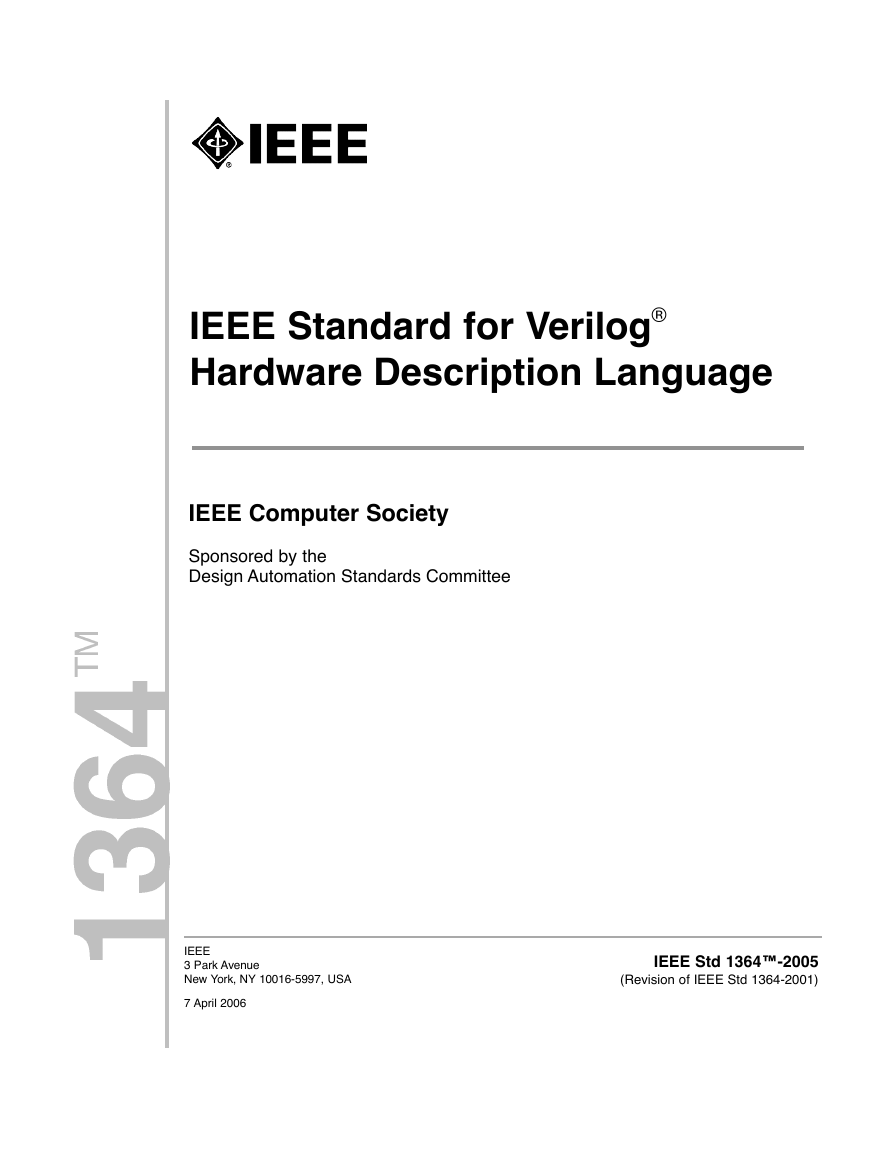

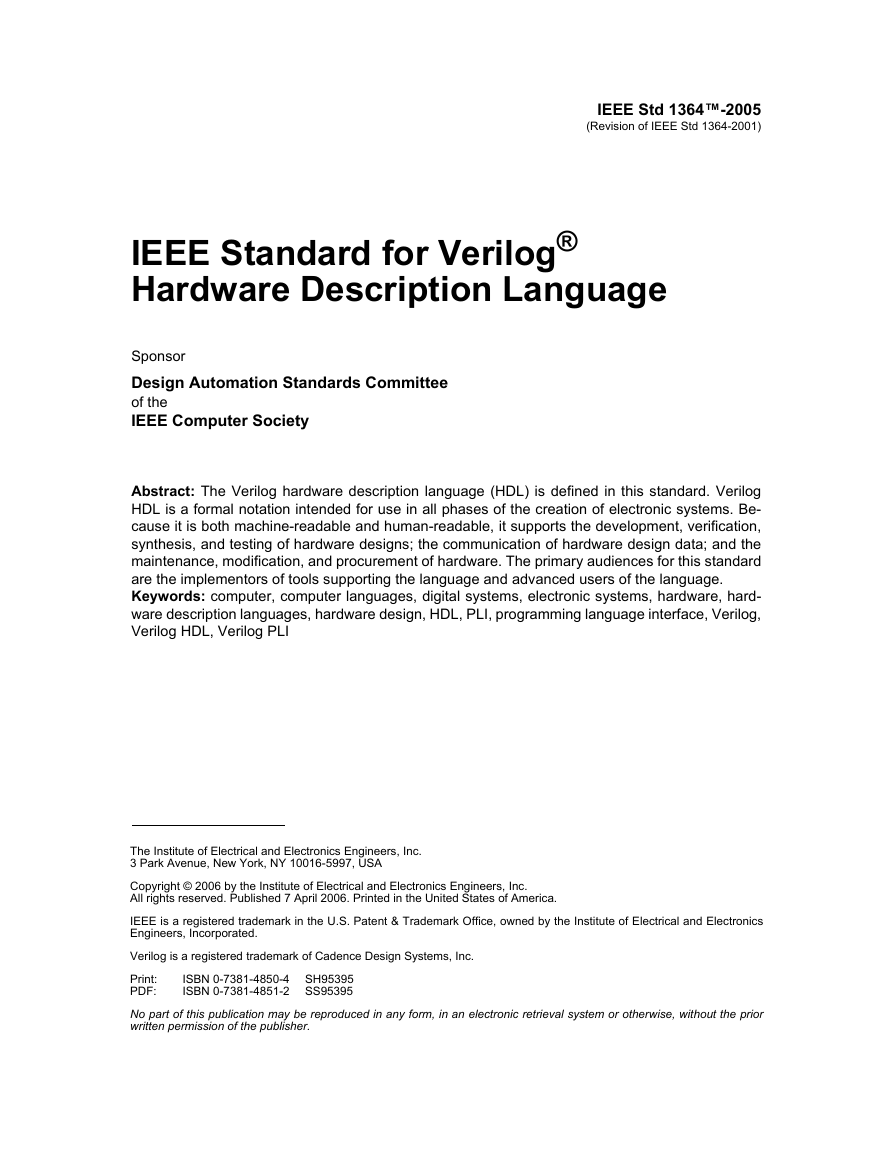

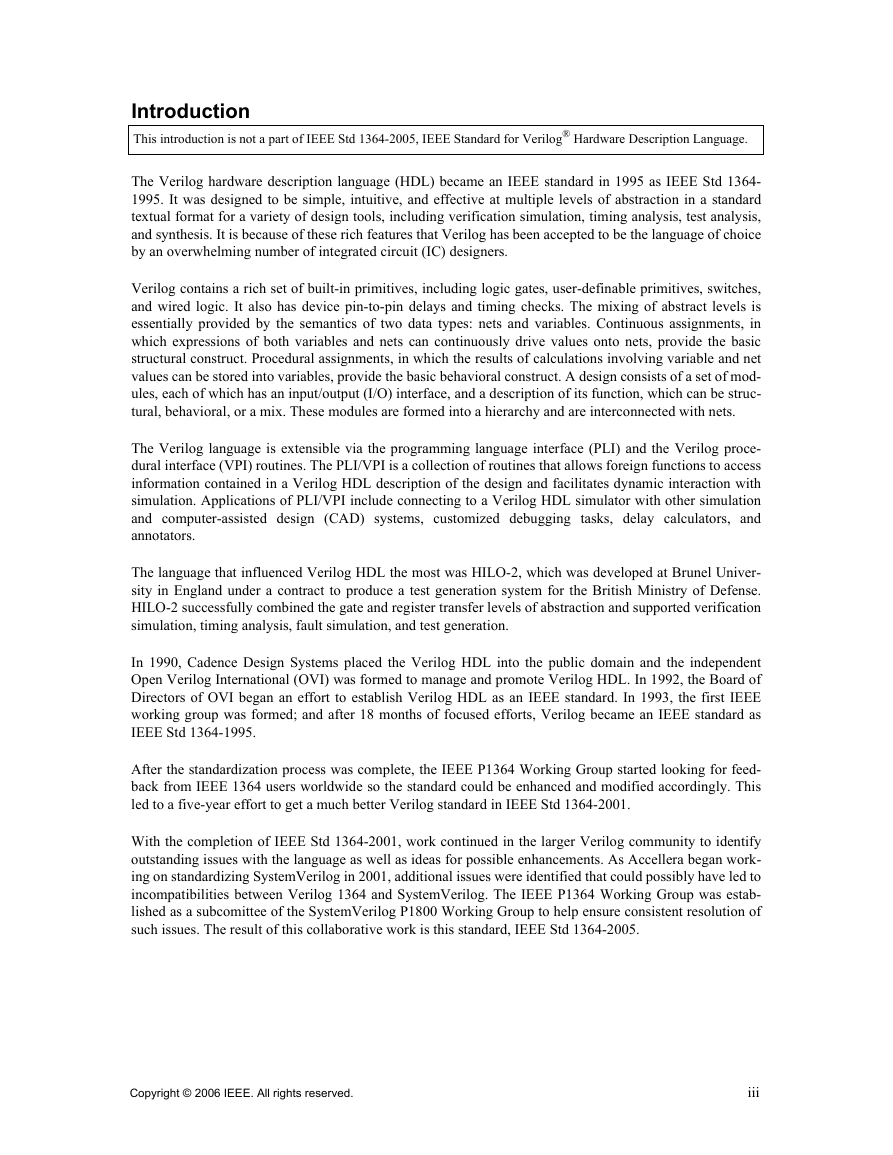

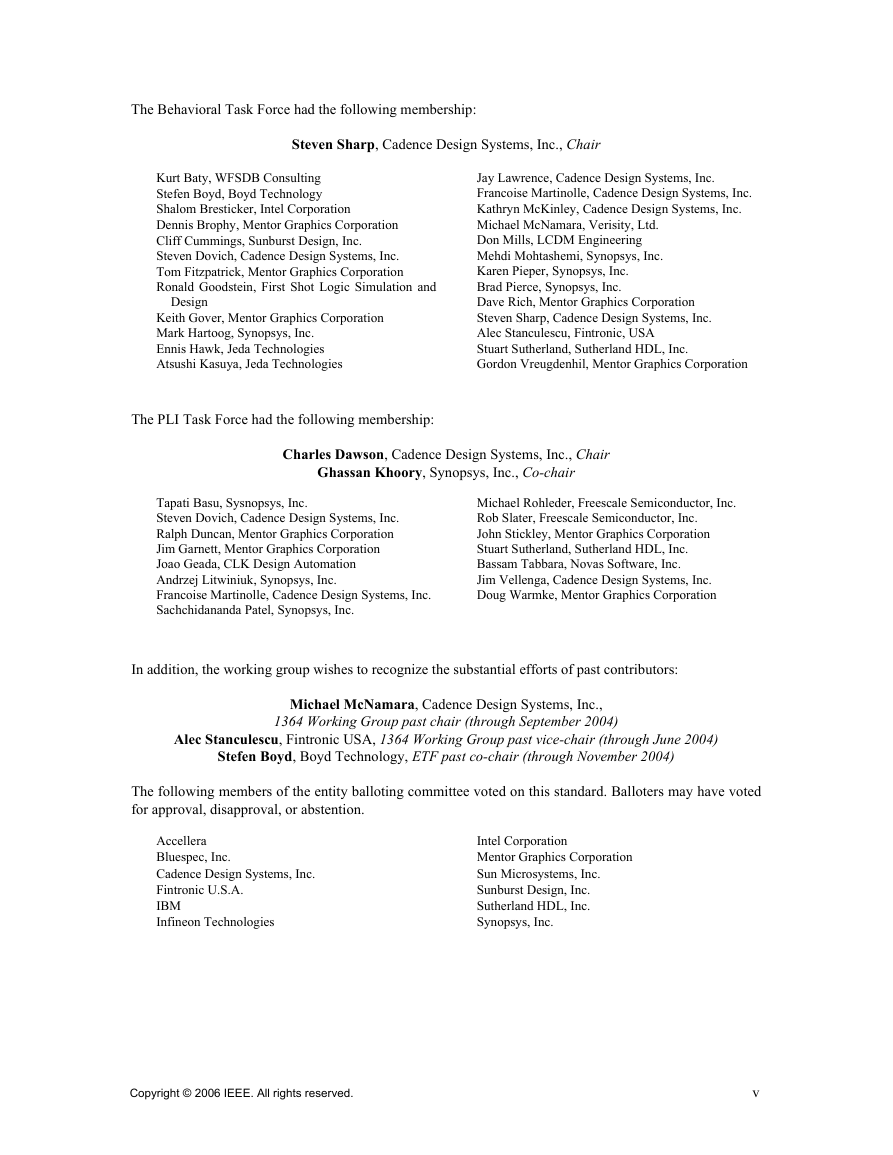
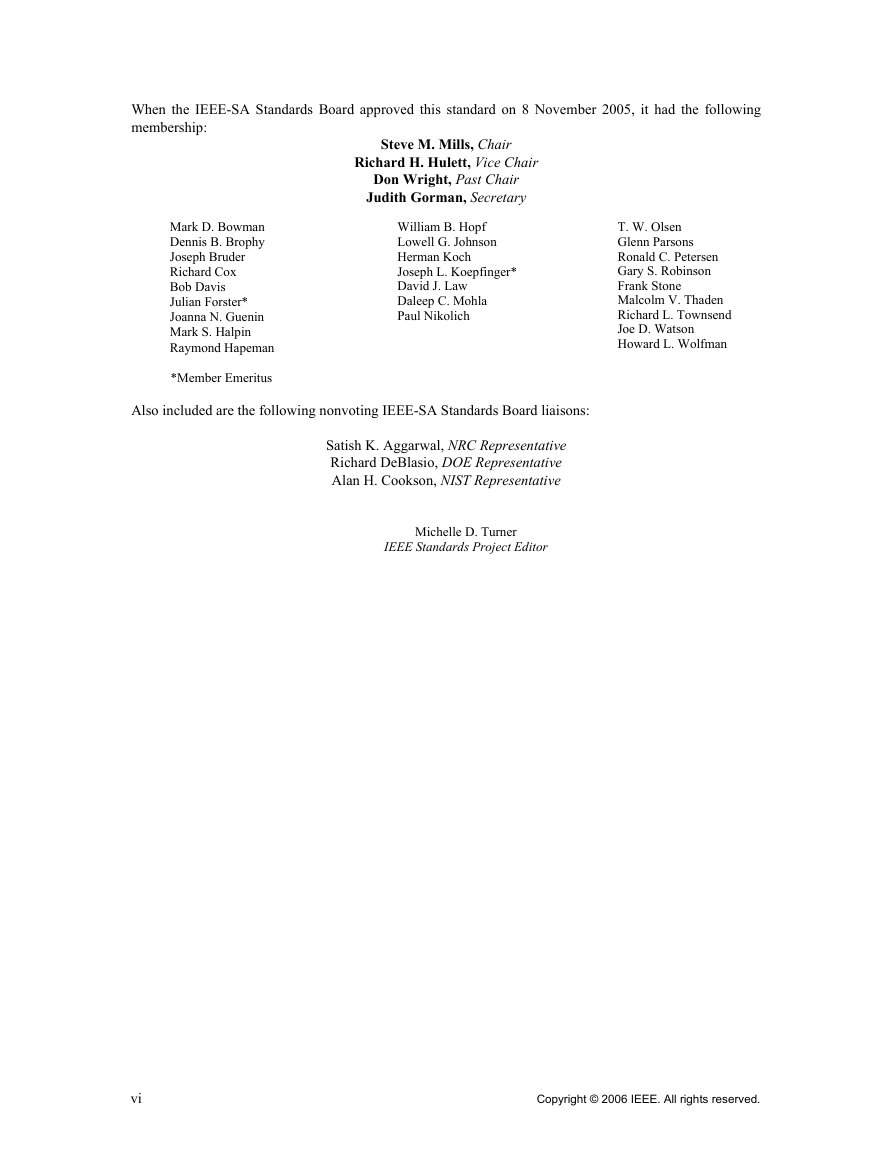








 2023年江西萍乡中考道德与法治真题及答案.doc
2023年江西萍乡中考道德与法治真题及答案.doc 2012年重庆南川中考生物真题及答案.doc
2012年重庆南川中考生物真题及答案.doc 2013年江西师范大学地理学综合及文艺理论基础考研真题.doc
2013年江西师范大学地理学综合及文艺理论基础考研真题.doc 2020年四川甘孜小升初语文真题及答案I卷.doc
2020年四川甘孜小升初语文真题及答案I卷.doc 2020年注册岩土工程师专业基础考试真题及答案.doc
2020年注册岩土工程师专业基础考试真题及答案.doc 2023-2024学年福建省厦门市九年级上学期数学月考试题及答案.doc
2023-2024学年福建省厦门市九年级上学期数学月考试题及答案.doc 2021-2022学年辽宁省沈阳市大东区九年级上学期语文期末试题及答案.doc
2021-2022学年辽宁省沈阳市大东区九年级上学期语文期末试题及答案.doc 2022-2023学年北京东城区初三第一学期物理期末试卷及答案.doc
2022-2023学年北京东城区初三第一学期物理期末试卷及答案.doc 2018上半年江西教师资格初中地理学科知识与教学能力真题及答案.doc
2018上半年江西教师资格初中地理学科知识与教学能力真题及答案.doc 2012年河北国家公务员申论考试真题及答案-省级.doc
2012年河北国家公务员申论考试真题及答案-省级.doc 2020-2021学年江苏省扬州市江都区邵樊片九年级上学期数学第一次质量检测试题及答案.doc
2020-2021学年江苏省扬州市江都区邵樊片九年级上学期数学第一次质量检测试题及答案.doc 2022下半年黑龙江教师资格证中学综合素质真题及答案.doc
2022下半年黑龙江教师资格证中学综合素质真题及答案.doc